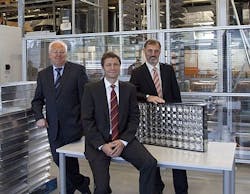Concentrator technology garners German Future Prize nomination
Freiburg, Germany--Hansjörg Lerchenmüller, Dr. Andreas Bett, and Dr. Klaus-Dieter Rasch have been nominated for the German Future Prize for their development of special solar cells, modules, and systems that can convert twice as much sunlight into electrical energy as silicon-based photovoltaic systems. The trio's technology yields multijunction solar cells that capture different ranges of the solar spectrum combined with lenses that concentrate the sunlightâknown as concentrator technology, which plays an important role in large power plants situated in sunny regions.
Annually, the German Future Prize jury nominates three teams that have successfully introduced new products to the market. The Federal President of Germany, Christian Wulff, attended the official nomination ceremony on August 27, 2011, at the IdeenExpo in Hannover, Germany, and will present the award to the winning team on December 14.
Fifteen years ago, researchers at Fraunhofer ISE stacked several layers of various semiconductors in one solar cell. In these tiny solar cells, which measure just 3 mm in diameter, semiconductors from groups III and V of the periodic table (GaInP, InGaAs, and Ge) are deposited on top of one another, capturing a different range of the solar spectrum and the energy yields add up, says Bett, director of the Materials â Solar Cells and Technology division and deputy director of Fraunhofer ISE.
The multijunction solar cells developed at Fraunhofer ISE are industrially manufactured by AZUR SPACE and used to supply energy for telecommunications satellites and terrestrial applications. The solar cells offer 41.1% efficiency and are currently being transferred to series production by AZUR SPACE. Dr. Klaus-Dieter Rasch, managing director of AZUR SPACE Solar Power GmbH in Heilbronn, believes that 50% efficiency will be realized soon as well.
Focusing on adapting multijunction solar cells for terrestrial applications, the researchers placed special lenses that concentrate sunlight by a factor of 500 in front of the multijunction solar cells, combining the cells and lenses in one module. Doing so allowed them to replace expensive semiconductor materials and produce a higher output per area, says Bett.

